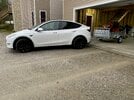Learning about Tesla battery health, degradation and such from AAKEE and other knowledgable forum members I put together a quick SS to track battery stats for my MYLR 3/23 and to see how they change over time. I know there are apps that will do the same/more out there but personally I just don't care enough to pay for subscription.
I left my data in the SS if anyone cares and did not clean up any calculations I've used while learning. Of course feel free to d/l, clear the data, reuse it and make what ever changes you want. Hope it helps
PS My MYLR by now has 3841 miles with daily drive of about 2-20 miles up/down the ski hill and few monthly round trips of about 440 miles long. I keep my car plugged in and charge to 50% unless going for a trip (trip charge is typically 70-90% mostly depending on if I am planning on pulling the trailer). When on 220 miles trips I make one 10-20 minutes stop to rest and L3 charge to have about 30% battery estimate for arrival. I know 30% estimate is super conservative but it works for me so I don't have to pay attention to speed, getting rained/snowed while driving and when pulling trailer with my garden tractor couple times a year.
I left my data in the SS if anyone cares and did not clean up any calculations I've used while learning. Of course feel free to d/l, clear the data, reuse it and make what ever changes you want. Hope it helps
PS My MYLR by now has 3841 miles with daily drive of about 2-20 miles up/down the ski hill and few monthly round trips of about 440 miles long. I keep my car plugged in and charge to 50% unless going for a trip (trip charge is typically 70-90% mostly depending on if I am planning on pulling the trailer). When on 220 miles trips I make one 10-20 minutes stop to rest and L3 charge to have about 30% battery estimate for arrival. I know 30% estimate is super conservative but it works for me so I don't have to pay attention to speed, getting rained/snowed while driving and when pulling trailer with my garden tractor couple times a year.
Attachments
Last edited:



